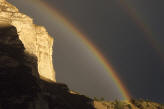|
|
Hiking
Over half of the visitors to Glacier National
Park report taking a hike. Thats a lot of hikers, but over 700 miles of
trail provide many outstanding opportunities for both short hikes and
extended backpacking trips.
Hikers need to assume individual responsibility for planning their trips
and hiking safely. Before setting out on your hike, stop by a park visitor
center to obtain needed warnings and recommondations. You will increase
your odds of a safe hike, decrease your disturbance to park wildlife, and
lessen cumulative damage to resources.
Visitor center bookstores carry a complete line of trail guides,
topographic maps and field guides to aid the hiker. Publications are also
available by mail. Call the Glacier Natural History Association at (406)
888-5756, to request a catalog.
Five self-guided walks interpret trailside features with brochures and
signs. The Trail of the Cedars, Huckleberry Mountain, Hidden Lake, Sun
Point, and Swiftcurrent Nature Trails encourage hikers to experience
Glacier National Park at their own pace. The Trail of the Cedars is
wheelchair accessible.
Good day hikes are plentiful. Visitor center staff will be happy to assist
you with your choices and provide free maps of popular trails in park.
Maps to four of the more popular hiking areas are available online as well
at the links above.
Backcountry
Camping
Glacier's backcountry is an amazing
place and is growing in popularity each year. Many resources are available
online for backcountry users to plan their trips. The most important is
the Backcountry Guide that is available as a PDF file.
In addition to the Backcountry Guide, the National
Park Service also provides Trail Status Reports, the Daily Backcountry
Bulletin, and a Reservation Status Report. All of these are updated
several times per day.
Click here for more information from the National Park Service.
Fishing
Around
the turn of the century, people started to look at the land differently.
Rather than just seeing the minerals they could mine or land to settle on,
they started to recognize the value of its spectacular scenic beauty.
Facilities for tourists started to spring up. In the late 1890's, visitors
arriving at Belton (now called West Glacier) could get off the train, take
a stagecoach ride a few miles to Lake McDonald, and then board a boat for
an eight mile trip to the Snyder Hotel. No roads existed in the mountains,
but the lakes allowed boat travel into the wilderness.
Soon people, like George Bird Grinnell, pushed for
the creation of a national park. Grinnell was an early explorer to this
part of Montana and spent many years working to get the park established.
The area was made a Forest Preserve in 1900, but was open to mining and
homesteading. Grinnell and others sought the added protection a national
park would provide. Grinnell saw his efforts rewarded in 1910 when
President Taft signed the bill establishing Glacier as the country's 10th
national park.
After the creation of the park, the growing staff
of park rangers needed housing and offices to help protect the new park.
The increasing number of park visitors made the need for roads, trails,
and hotels urgent. The Great Northern Railway built a series of hotels and
small backcountry lodges, called chalets, throughout the park. A typical
visit to Glacier involved a train ride to the park, followed by a
multi-day journey on horseback. Each day after a long ride in the
mountains, guests would stay at a different hotel or chalet. The lack of
roads meant that, to see the interior of the park, visitors had to hike or
ride a horse. Eventually, the demand for a road across the mountains led
to the building of the Going-to-the-Sun Road.
Bicycling
In Glacier, bicycles are restricted to roadways, bike routes, or parking
areas and are not allowed on trails.
Waterton Lakes National Park allows bicycling on
some trails.
Cyclists must observe all traffic
regulations. Keep well to the right side of the road and ride in single
file only. Pull off the road if four or more vehicles stack up behind you.
In fog or after dark a white light in front and a red reflector on the
rear of your bicycle are required. Be visible! Helmets are strongly
advised. Attach a bright flag on a pole and wear light-colored clothing.
Watch for falling rocks, drainage grates, and ice on road.
For safety and to ease congestion,
restrictions are in effect on sections of the Going-to-the-Sun Road, from
June 15 through Labor Day:
-
From Apgar Campground to Sprague
Creek Campground bicycles are prohibited, both directions, between 11
a.m. and 4 p.m.
-
From Logan Creek to Logan Pass
east-bound (uphill) bicycle traffic is prohibited between 11 a.m. and 4
p.m.
Start early! It takes about 45
minutes to ride from Sprague Creek to Logan Creek and about three hours
from Logan Creek to Logan Pass.
Bicycle rentals are not available
inside the park.
A limited number of sites at Apgar,
Fish Creek, Sprague Creek, Avalanche, Many Glacier, Rising Sun, Two
Medicine, and St. Mary campgrounds are held until 9:00 p.m. for
bicyclists, pedestrians, and motorcyclists. Sites are shared and have a
capacity of 8 people; larger groups must split up. The fee is $3.00 per
person. If hiker/biker sites are full, campers must use regular unoccupied
campsites.
|

